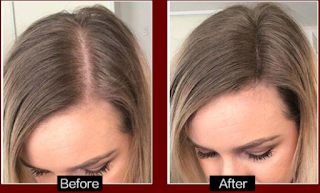Receding hairline affects both men and women, with women usually having finer and softer hair that’s also more susceptible to damage. But one of the biggest concerns in receding hairline in women is finding ways to cope with thinning or falling out hair without losing confidence in your appearance. Here are some things to consider when receding hairline starts affecting your hairstyle
Traction alopecia
Wearing high ponytails
Having long hair
Stress/anxiety
About 80% of those who experience hair loss are women. Hair loss in women usually begins with hair thinning in your 20s, around age 30 or so; by 50 years old, half of all American women will have noticeably thinning hair. The most common cause of receding hairlines in women is hereditary—meaning it’s passed down genetically from your parents—and it’s also known as female pattern baldness or FPHL.
 |
Breakage
Excessive or incorrect styling and blow-drying are some of the most common culprits for hair loss. If you don’t know how to use your blow-dryer, get in touch with a stylist who can show you how to avoid breakage. When using hot tools (such as flat irons, curling irons, etc.), always be careful not to hold them too close to your scalp; using high heat can cause serious damage. Make sure that you protect your hair from excessive heat by allowing it plenty of air time before and after each application of styling tools.
Hormonal Changes
 |
A common reason for female hair loss and receding hairline is hormonal changes such as pregnancy, menopause, or even stress. This type of hair loss usually reverses after your hormones balance out, but in some cases, it may be permanent. Be sure to talk to your doctor if you are experiencing female pattern baldness that began during or after pregnancy. And there’s no shame in taking minoxidil while pregnant since it is only available by prescription. But keep in mind that minoxidil can cause abnormal heart rhythms, so talk to your doctor before taking any medications while pregnant or breastfeeding.
Unhealthy habits
There are many reasons why you might be losing your hair, but none of them are good. Luckily, most of these issues can be treated with healthy lifestyle changes. Eating healthily and exercising regularly have been shown to prevent hair loss in some women (and men!). Smoking can also cause you to lose your hair prematurely, as can wearing tight hairstyles for long periods of time. If you’re experiencing thinning hair, consult your doctor and make sure everything’s okay. Just remember: addressing unhealthy habits early on will prevent further hair loss down the road.
Medications
There are multiple medications on the market that treat hair loss in women. However, not all of them have been clinically tested and approved for use by women. The FDA only recently approved two of these drugs—Finasteride and Minoxidil—for use in female patients. Both of these treatments work to slow hair loss and even regrow some lost hair over time. In some cases, they can reverse male pattern baldness in women as well as men. If you think either drug might be right for you, talk to your doctor about risks and side effects before beginning treatment with Finasteride or Minoxidil. They do have to be taken on a long-term basis in order to produce lasting results.





